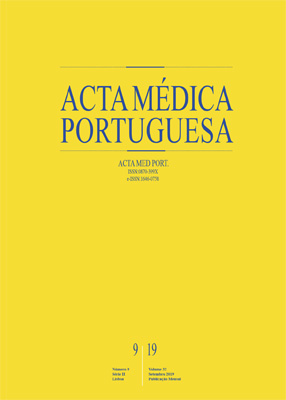A Dermatite Atópica em Revisão
DOI:
https://doi.org/10.20344/amp.11963Palavras-chave:
Dermatite Atópica/complicações, Dermatite Atópica/diagnóstico, Dermatite Atópica/epidemiologia, Dermatite Atópica/etiologia, Dermatite Atópica/prevenção e controlo, Dermatite Atópica/tratamentoResumo
Com uma prevalência crescente nas últimas décadas, a dermatite atópica tornou-se um problema de saúde global. Foi realizada uma revisão não sistemática com base numa pesquisa bibliográfica direcionada à epidemiologia, fisiopatologia, características clínicas, comorbilidades e tratamento da dermatite atópica. Em resumo, a dermatite atópica é uma patologia cutânea heterogénea associada a morfologia, distribuição e curso da doença variáveis. A sua patogénese é complexa, combinando fatores genéticos e ambientais que condicionam a disfunção da barreira epidérmica, a desregulação imune cutânea e sistémica e a disbiose do microbioma da pele. O diagnóstico baseia-se em critérios clínicos específicos, incluindo história pessoal e familiar de atopia, evolução da doença e manifestações clínicas. A gravidade da doença é determinada através da avaliação dos sinais objetivos e dos sintomas subjetivos. A sua abordagem deve ser progressiva, focada na redução do prurido e no controlo da doença. Os doentes devem ser aconselhados sobre os cuidados básicos a ter e evicção de agressores externos. Em situações de agudização ou lesões crónico-recidivantes, devem ser aplicados anti-inflamatórios tópicos. Na ausência de resposta ou controlo adequado no médio prazo, deve ponderar-se fototerapia, imunossupressores sistémicos ou, mais recentemente, dupilumab. Contudo, o tratamento da dermatite atópica moderada a grave permanece desafiador, sendo urgente o desenvolvimento de novas terapêuticas, eficazes, seguras e direcionadas. Concluindo, apesar de atualmente haver uma melhor compreensão e um maior conhecimento da doença, as investigações futuras deverão continuar a explorar a interação entre fatores genéticos e ambientais e seus efeitos na fisiopatologia e gravidade da doença, bem como nos resultados do tratamento.
Downloads
Downloads
Publicado
Como Citar
Edição
Secção
Licença
Todos os artigos publicados na AMP são de acesso aberto e cumprem os requisitos das agências de financiamento ou instituições académicas. Relativamente à utilização por terceiros a AMP rege-se pelos termos da licença Creative Commons ‘Atribuição – Uso Não-Comercial – (CC-BY-NC)’.
É da responsabilidade do autor obter permissão para reproduzir figuras, tabelas, etc., de outras publicações. Após a aceitação de um artigo, os autores serão convidados a preencher uma “Declaração de Responsabilidade Autoral e Partilha de Direitos de Autor “(http://www.actamedicaportuguesa.com/info/AMP-NormasPublicacao.pdf) e a “Declaração de Potenciais Conflitos de Interesse” (http://www.icmje.org/conflicts-of-interest) do ICMJE. Será enviado um e-mail ao autor correspondente, confirmando a receção do manuscrito.
Após a publicação, os autores ficam autorizados a disponibilizar os seus artigos em repositórios das suas instituições de origem, desde que mencionem sempre onde foram publicados e de acordo com a licença Creative Commons









